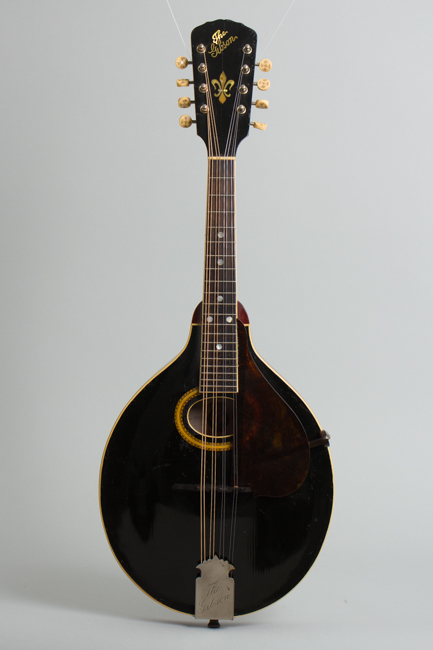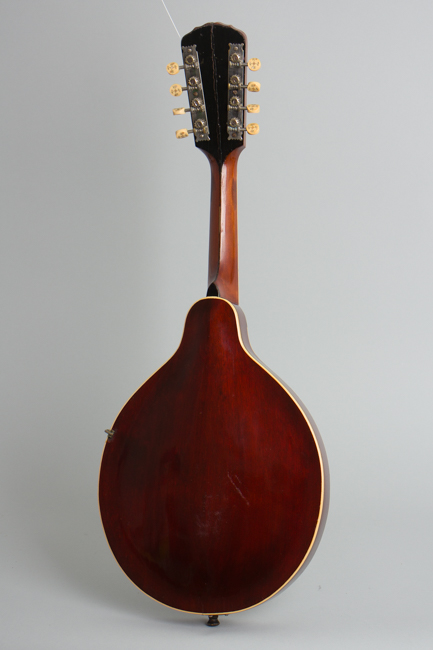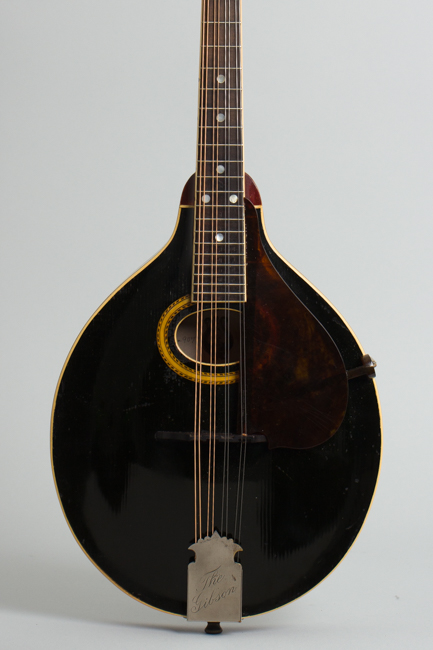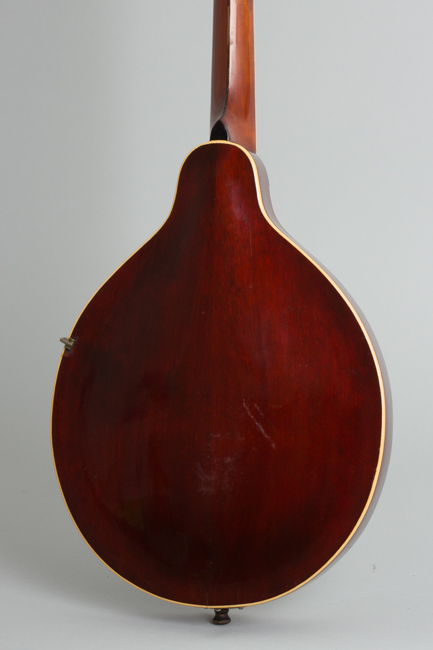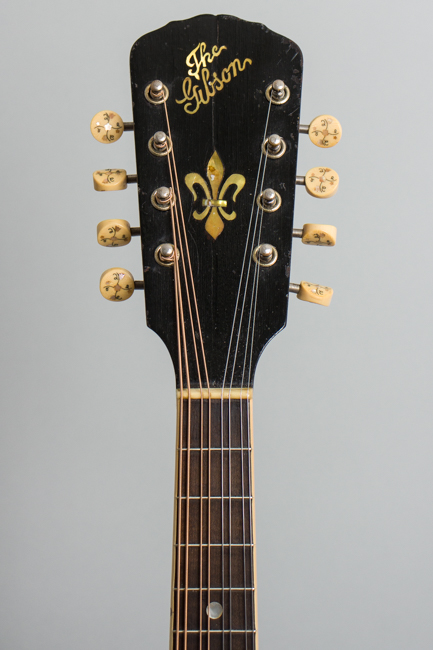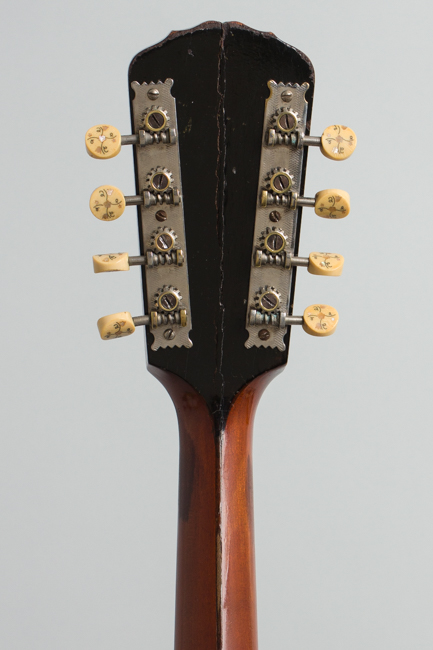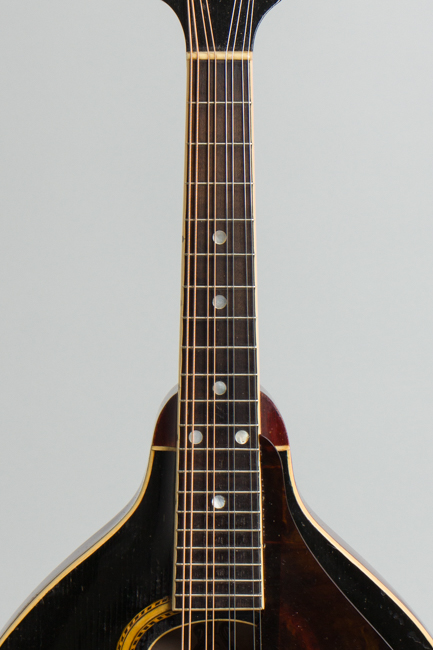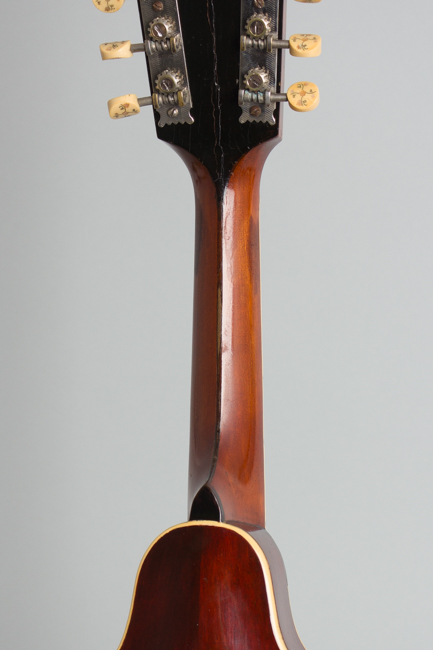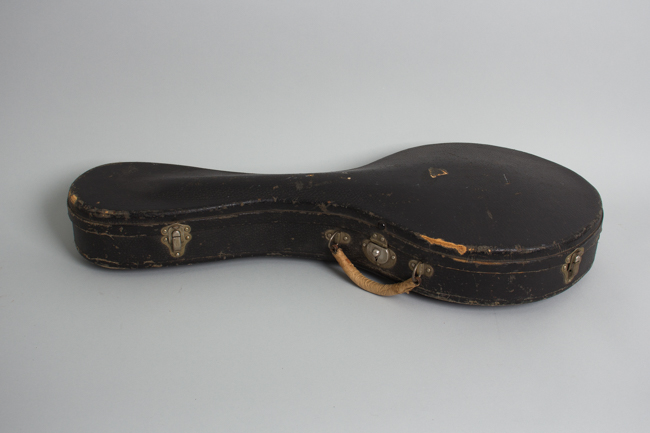Gibson A-4 Carved Top Mandolin (1909)
Gibson A-4 Model Carved Top Mandolin (1909), made in Kalamazoo, Michigan, serial # 9077, black top, natural back and sides finish, birch back and sides, spruce top, mahogany neck with ebony fingerboard, period black hard shell case.
This is a very cool early transitional example of the Model A-4, Gibson's highest priced "A"-style oval-bodied mandolin. Based on both the four-digit serial number and the three-digit Factory Order Number stamped on the inside heel (#911) It dates to late 1909, the period when Gibson were just establishing themselves as THE major force in the mandolin market. Right at this point, Gibson employee George Laurian was busy re-developing the company's instruments into what they became in the 1910s.
Laurian made many improvements to Orville Gibson's original designs, starting as early as 1904. In 1909 he began developing the "modern" sharper neck angle, which improved both volume and tone dramatically. The patent for the new carved ebony bridge issued in his name is dated September of this year, so this mandolin would be one of the first of these improved models. It also features one of the earliest elevated pickguards ("Guard plate" in Gibson nomenclature) another Laurian innovation stamped "Pat. Applied For". The securing clamp is the initial violin-style version only used for a short time. The white paper label under the soundhole is the original style with Orville Gibson's face peering out of the center of a lyre-mandolin, another soon-to-disappear item.
This period's A-4 also features a rakish black top finish, pearl and wire inlaid grained ivoroid buttons on the Handel tuners and a pearl fleur-de-lis and "The Gibson" logo on the headstock. The sound on this 1909 mandolin is more developed compared to instruments from even a year earlier, and genuinely superior (at least to modern ears) to anything else available at the time. Over the next couple of years the company would further develop their mandolin family instruments into the classic 1910s pieces still well know and played today. This early A-4 is surprisingly close to its later 1910s siblings with a full and surprisingly powerful sound. This is a really nice historic piece and a beautiful playable piece of Art Nouveau, and an early example of the instruments with which Gibson first conquered the fretted world.
Overall length is 25 1/2 in. (64.8 cm.), 10 1/16 in. (25.6 cm.) across at the widest point, and 1 13/16 in. (4.6 cm.) in depth, measured at side of rim. Scale length is 14 in. (356 mm.). Width of nut is 1 1/8 in. (29 mm.).
Considering it is now 115 years old this is a very good-playing old A-4, showing some wear and typical repairs but no notable alterations. The original varnish finish shows scuffs, scratches and dings, most notably pick wear into the top near the soundhole. There is playwear to the back of the neck, but only down to the wood on the sides in the first position. The finish on the sides appears to have been polished out long ago.
The seam in the neck lamination on the headstock had separated and been reglued, solidly but visibly. This is a common repair on these older Gibsons with a dyed pearwood center strip. The seam is visible on the face veneer of the headstock but was not fully cracked through. There are no other cracks, though a few edge seams may have been resealed as is typical.
The hardware appears mostly original including the lovely inlaid Handel tuners, the early "pineapple" styler tailpiece cover and the first generation pickguard and clamp. The bridge appears to be a later c.1920 carved Gibson non-adjustable ebony piece, but looks like it has been on the instrument since practically new. The neck is amazingly straight and the original thin frets have been crowned down a bit and still play well.
This is a really cool and historic A-4 with the sonic advantages of the first second-generation instruments combined with some of the earlier cosmetics, including the ghostly Orville label. It sings with a sweet but ringing sound with a nice, woody overtone. It is ready to gig, complete in a period Gibson HSC, probably just a few years later than the itself in solid condition for a century or so on. Overall Very Good + Condition.
This is a very cool early transitional example of the Model A-4, Gibson's highest priced "A"-style oval-bodied mandolin. Based on both the four-digit serial number and the three-digit Factory Order Number stamped on the inside heel (#911) It dates to late 1909, the period when Gibson were just establishing themselves as THE major force in the mandolin market. Right at this point, Gibson employee George Laurian was busy re-developing the company's instruments into what they became in the 1910s.
Laurian made many improvements to Orville Gibson's original designs, starting as early as 1904. In 1909 he began developing the "modern" sharper neck angle, which improved both volume and tone dramatically. The patent for the new carved ebony bridge issued in his name is dated September of this year, so this mandolin would be one of the first of these improved models. It also features one of the earliest elevated pickguards ("Guard plate" in Gibson nomenclature) another Laurian innovation stamped "Pat. Applied For". The securing clamp is the initial violin-style version only used for a short time. The white paper label under the soundhole is the original style with Orville Gibson's face peering out of the center of a lyre-mandolin, another soon-to-disappear item.
This period's A-4 also features a rakish black top finish, pearl and wire inlaid grained ivoroid buttons on the Handel tuners and a pearl fleur-de-lis and "The Gibson" logo on the headstock. The sound on this 1909 mandolin is more developed compared to instruments from even a year earlier, and genuinely superior (at least to modern ears) to anything else available at the time. Over the next couple of years the company would further develop their mandolin family instruments into the classic 1910s pieces still well know and played today. This early A-4 is surprisingly close to its later 1910s siblings with a full and surprisingly powerful sound. This is a really nice historic piece and a beautiful playable piece of Art Nouveau, and an early example of the instruments with which Gibson first conquered the fretted world.
Overall length is 25 1/2 in. (64.8 cm.), 10 1/16 in. (25.6 cm.) across at the widest point, and 1 13/16 in. (4.6 cm.) in depth, measured at side of rim. Scale length is 14 in. (356 mm.). Width of nut is 1 1/8 in. (29 mm.).
Considering it is now 115 years old this is a very good-playing old A-4, showing some wear and typical repairs but no notable alterations. The original varnish finish shows scuffs, scratches and dings, most notably pick wear into the top near the soundhole. There is playwear to the back of the neck, but only down to the wood on the sides in the first position. The finish on the sides appears to have been polished out long ago.
The seam in the neck lamination on the headstock had separated and been reglued, solidly but visibly. This is a common repair on these older Gibsons with a dyed pearwood center strip. The seam is visible on the face veneer of the headstock but was not fully cracked through. There are no other cracks, though a few edge seams may have been resealed as is typical.
The hardware appears mostly original including the lovely inlaid Handel tuners, the early "pineapple" styler tailpiece cover and the first generation pickguard and clamp. The bridge appears to be a later c.1920 carved Gibson non-adjustable ebony piece, but looks like it has been on the instrument since practically new. The neck is amazingly straight and the original thin frets have been crowned down a bit and still play well.
This is a really cool and historic A-4 with the sonic advantages of the first second-generation instruments combined with some of the earlier cosmetics, including the ghostly Orville label. It sings with a sweet but ringing sound with a nice, woody overtone. It is ready to gig, complete in a period Gibson HSC, probably just a few years later than the itself in solid condition for a century or so on. Overall Very Good + Condition.
